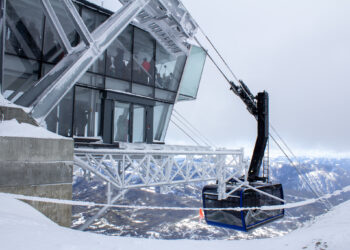By Tyler Allen Explorebigsky.com Contributor
Montana is characterized by abundant natural resources:
wide open spaces, valuable
minerals, plentiful wildlife,
vast forestlands, and energy.
This last resource is dominated
by coal and hydroelectric
power, but there is enormous
potential for renewable
energy. As evidence mounts
that burning fossil fuels has
a negative impact on the
earth, and that the resulting
climate change affects our
quality of life and our future,
more Montanans are looking
toward alternatives to power
their lives.
While the state’s energy future seems secure
(Montana is a net exporter of energy),
that power is largely produced from
coal beds in the Powder River Basin and
from large hydroelectric dams—these
sources are not eternal, and they visibly
degrade Montana’s natural beauty.
However, Montana is also rich in other
energy resources that do little harm to
our valuable landscape:
• Montana is ranked in the top five of
U.S. states in wind energy potential.
• Southwest and Eastern Montana
have vast solar resources.
• Biomass is emerging as an economically
viable solution to utilize the
byproducts of forest management.
• Geothermal heat pumps have begun
heating homes around Montana.
Currently, “net-metered” systems dominate
Montana’s renewable energy—more
than 1,000 small-scale residential wind
turbines or rooftop solar panels. When
power generated by these systems is
greater than the demand of the household,
the energy is sent back to the grid.
photo courtesy of independent power systems
“Net-metering is easing the load on
the grid,” says Conor Darby, President
of Montana Renewable Energy Association.
“It is going to the root of the
problem, decreasing demand, which
means less electricity bought from the
coal plants.” Because Montana companies
install these net-metered systems,
they boost local economies.
In contrast, large wind farms or solar
installations are often built by out-ofstate
companies, employ out-of-staters
and sell power to other states with
greater demand. These projects must
to be tied to the larger power grid, and
high voltage power lines can cost thousands
of dollars per mile, in addition to
having a visual impact.
The federal government is offering
a 30 percent tax credit on residential
power systems using renewable
energy, and the state of Montana is
providing tax credits on investments of
$5,000 or more. There has never been
a better time to invest in an energy future
that does not depend on our finite
supply of fossil fuels.
BIOMASS
Despite Montana’s abundant timber
resources, biomass power generation
is currently only being used as
a substitute for fossil fuels in heating
public buildings—this is largely
because the cost of electricity is so
low. The University of Montana is in
the permitting stage for a biomass
electricity generator.
The Healthy Forest Initiative, which
has created a number of fuel
reduction projects statewide, is
challenged to find “a market for all
the un-merchantable materials,”
says Crystal Hagerman, Natural
Resource Agent with the MSU Extension.
Hagerman explains finding
ways to save landowners money
will encourage forest management,
but companies are hesitant
to stick their necks out by building
industrial pellet plants. Why? The
source—waste from marketable
trees—could run out in 20 years. In
the Big Sky area, logging waste is
often chipped and broadcast on site
or hauled away.
The Fuels for Schools and Beyond
(FFS &B) program was created
after the devastating wildfires of
2000, when 350,000 acres burned
in the Bitterroot Valley. A resident
in Darby, Montana began researching
how fuel reduction and
economic development could be
tied together, and learned a number
of schools in the northeastern
U.S. were using biomass boilers
to heat buildings. By fall of 2003,
biomass boilers were installed
in three Darby schools, and
since then, a number of schools
throughout Montana have used
the FFS &B grant funding for their
own biomass projects.
Biomass projects aren’t feasible
for smaller facilities. A building
must spend an estimated
$20,000 a year on heating fuel
for a conversion to be cost-effective,
and proximity to a wood
fuel source is key. As with any
heating system, it’s cheaper to
install a biomass burner in new
construction than retrofitting it
to an existing system.
Moonlight Basin has received a
grant from the Montana Department
of Natural Resources to study
feasibility of biomass for their proposed
expansion.
“[This] will help us determine if
biomass is economically viable,
environmentally friendly, and
sustainable as a fuel source,” says
Kevin Germain, Director of Planning
and Development for the
resort. Moonlight is investigating
biomass both as a cost-saving
measure, and as a way to reduce
its carbon footprint. Creating a
market for the low-value logging
slash from their wildfire and
disease/insect mitigation efforts is
another benefit, Germain says.
WIND
[dcs_img] https://www.explorebigsky.com/wp-content/uploads/2011/02/wind-turbines.jpg[/dcs_img]
The U.S. Department of Energy
(DOE) expects wind power will
contribute 20 percent of the nation’s
electricity by 2030. Although
Montana is ranked in the top five
states in wind energy potential,
it’s 18th in actual generation.
Currently, only 10 percent of our
power is derived from wind.
Unlike conventional sources of
energy, wind power creates zero
emissions, consumes no water
during operation, and costs nothing
once turbines are installed.
Energy from fossil fuels is required
for the manufacture and
transportation of wind turbines,
but it is estimated that within a
few months of operation, a wind
farm produces an equivalent
amount of clean energy.
The initial investment is not cheap
though: development of commercial
wind farms costs around
$2 million/megawatt (mW) of
generating capacity, and a typical
residential wind turbine costs
approximately $32,000. Since new
high voltage lines are so expensive
to build, another issue with wind
farms is how far the sites are from
existing transmission lines.
The Judith Gap wind farm, near
Harlowton, Montana became
operational in January 2006. The
90 towers rise 262’ above the
grassland and produce 450,000,000
kilowatts (kW) annually. Each turbine
has three blades 126’ long, and
power production begins with wind
speeds of 7.8 mph. When the wind
blows over 56 mph, the turbines
automatically shut down to protect
them from damage. A 20-year
Power Purchasing Agreement with
Northwestern Energy ensures this
clean energy will contribute to the
grid for decades to come.
As with most renewable energy
systems, an investment in wind
eventually pays for itself and saves
the consumer money—especially in
the current incentive climate. Montana
offers a wind energy system
tax credit of 35 percent for individuals
or corporations that invest at
least $5,000 in equipment, transmission
lines or equipment used in
the manufacture of wind turbines.
The DOE estimates this industry
has potential to create 2,800 jobs in Montana.
SOLAR
Solar power is the world’s fastest growing energy
source. Solar cells generate electricity from the sun
as a result of the photovoltaic effect; photons of light
knock the electrons in the cells into a higher state of
energy, creating voltage between two electrodes. Even
considering the emissions produced in manufacturing
photovoltaic cells, solar power produces less than 15
percent of the carbon dioxide as equivalent energy from
a coal-fired plant.
Solar panels have a life expectancy of 50 years, and are
designed to withstand strong winds, corrosion and heavy
Rocky Mountain snow loads.
Southwest Montana has a great solar resource, with
Gallatin Valley averaging 4.7 peak sun hours daily. Even
so, it’s unlikely large solar panels will dot the landscape
anytime soon.
At present, solar energy exists only in net-metering
systems, because procurement costs are higher than
for wind. While Montana law says the state must supply
20 percent of its energy in renewable sources by 2015,
energy companies are not required by law to purchase
solar power like in other states.
REC Silicon provides 300 jobs in Butte producing silicon
products for the solar and electronics industry, and a
number of installers are working across the state.
Through the Sun4Schools program, solar panels have
also been used as a teaching tool in Montana. Between
2000 and 2003, photovoltaic systems were installed at
27 schools in North Western Energy’s service area. This
program demonstrated that solar power provides clean
energy, reduces greenhouse gas emissions and has a
positive environmental impact.
GEOTHERMAL
Another heating alternative to
fossil fuels gaining a foothold
in Montana is geothermal, or
ground-source, heat pumps. The
upper 10’ of the Earth’s surface
maintains a relatively stable temperature
of 45-70 degrees F, and
a geothermal heat pump takes
advantage of that stored heat to
warm a building in the winter. In
addition, the pumps cool a house
in the summer by pumping its
heat into the ground.
Heat is captured by circulating
fluid through high-density polyurethane
pipes in the ground
or a nearby body of water. The
fluid returns to the home and is
compressed by the heat pump
to be circulated through the
building using forced air or
radiant floor heating.
Four types of systems can be
installed, depending on a site’s
topography. The most common is
a Horizontal Loop, where pipes
are buried in trenches 6-8’ deep
and 100-300’ long. When terrain
or existing landscaping is
limiting, a Vertical Loop is often
installed, with holes drilled 100-
400’ below the surface. If there
is a large body of water nearby,
pipes can be sunk and anchored
to the bottom—a Pond Loop. An
Open Loop system can be used
if there is an adequate supply
of high quality well water, and
an appropriate discharge area
nearby such as a river or pond.
The initial investment can be
expensive, but a geothermal
system will pay for itself quickly
because it is 3-4 times more
efficient than conventional heat
systems. The cost of fossil fuels
is likely to rise, but the heat
captured from the earth will
always be free. And groundsource
heating systems are
more reliable than conventional
systems, which typically last
13-15 years. The heat pumps
are expected to last 20-25
years and the pipes have a life
expectancy of 50 years. The 30
percent tax incentive from the
federal government applies
to geothermal, as well, so the
payback period is even shorter.
This story was first published in the summer 2011 issue of Mountain Outlaw magazine.













